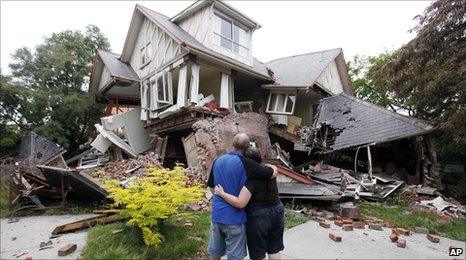Christchurch: Broken city faces life after quake
- Published

Many Christchurch residents are facing months of rebuilding
As the grim toll from the Christchurch earthquake continues to rise, New Zealand's shattered southern city has been rattled by a series of aftershocks.
Buildings again convulse under the power of unpredictable underground forces and for a few seconds walls and windows shudder.
At first there is a rumble like distant thunder before the earth shifts underfoot, then within a few seconds all is still.
Some of the jolts have measured up to magnitude 4.5, far less menacing than Tuesday's quake, which witnesses say made the streets of Christchurch roll and rise like a wave.
But more than 100 aftershocks have made an anxious city even more fearful.
"Even the little tremors bring back the terror of the big one," said Roger Marshall, 32, who had brought his young family to an evacuation centre set up at the Burnside High School in Christchurch.
Roger Marshall and his family saw the house opposite them collapse
Here the homeless have sought shelter as they swap horrible stories of the day Christchurch changed forever.
"The house was totally shaken and when we did get outside, the three-storey house across the road was just one storey and there's hands and limbs sticking out and (people) saying 'help, help, help!'. It was unreal," said Mr Marshall.
"We had cars falling into holes and everything was upside down. It was the worst I've ever felt in my life."
The ripples of the disaster have spread far beyond New Zealand. Japanese, Chinese, Filipino and Thai students are among the missing, while there have been Australian and Irish casualties. A British survivor is in hospital with severe injuries.
UK diplomats have set up a crisis centre at a hotel near Christchurch airport to issue emergency passports and help its citizens escape the quake zone.
Tony McLeod, the consular manager for the British High Commission, said he had been stunned by the scale of the destruction.
"I've seen things that normally you associate only with stuff on newsreels, of private vehicles and trucks being used as ambulances," he said.
"That brought it home to me, when a city like Christchurch runs out of ambulances then things are pretty severe."
Bewilderment
It is the heart of Christchurch that has suffered the most, where landmarks and office blocks lie twisted and broken.
Central areas remain sealed off by the military, with roads blocked by soldiers and armoured personnel carriers.
No-one knows the sort of horrors that are buried beneath the rubble but as rescuers begin a third night searching for survivors, New Zealand's Prime Minister John Key has warned the country to brace itself for more traumatic news.
Teams from around the world are searching the city for survivors
Emergency workers, though, are optimistic that life will be found in the wreckage more than two days after the earthquake. A British search and rescue team has recently landed in Christchurch joining others from the United States, Japan and Australia.
Its spokesman, Peter Crook, told the ДѓЯѓДЋУН that his specialist unit was hoping to find survivors.
"At this stage it's still rescue. Clearly, as time goes on hopes diminish, but we've rescued people far further than this into an earthquake scenario," he said.
"Normally four or five days is the window we have to work in, so we've only a couple of days left out of that."
As the rescue mission continues, there is a discernible sense of bewilderment here as the aftershocks continue to shake this fragile corner of New Zealand.
The authorities are urging residents to leave the city but many are worried about looters targeting empty houses or want to stay to do their bit to help in the immense recovery effort.
Christchurch may never be the same again but Mr Key says now is the time for the city's "great comeback" to begin.
- Published23 February 2011
- Published23 February 2011